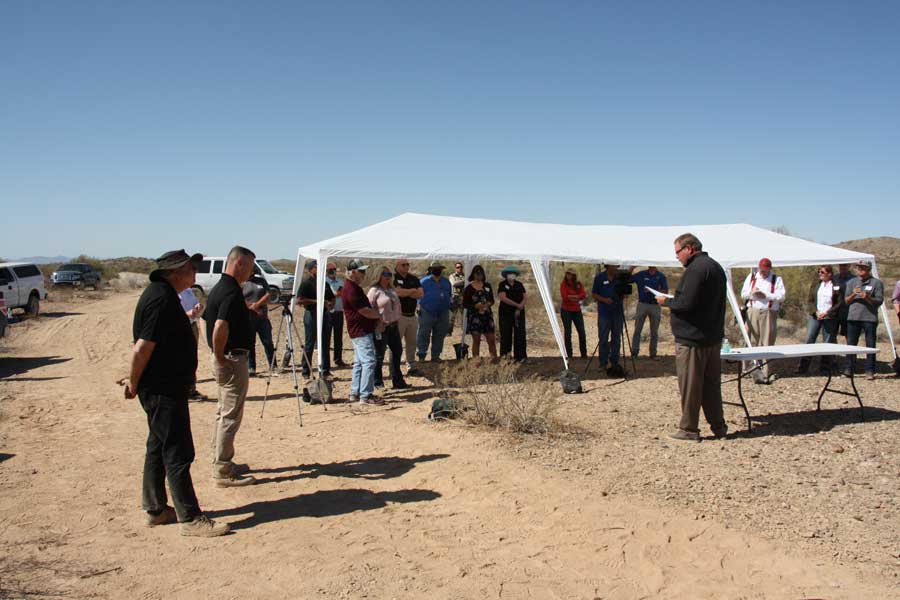US throws weight behind American Rare Earths’ La Paz project
Mining
Mining
The US government is showing just how serious it is about securing its rare earths supply chain in making clear its support of American Rare Earths’ La Paz scandium and rare earths project in Arizona.
La Paz has received the backing of government officials at not only a local level, but also a national level after being one of few projects to be exempted from the Biden Administration’s 60-day halt on ground disturbing activity approvals.
And last week roughly 20 federal, state, county, and city officials, plus private industry executives visited the La Paz project where Marty Weems, CEO of American Rare Earths’ wholly owned US subsidiary Western Rare Earths, gave a presentation on the importance of the project.
This public show of support comes as tensions between China and the US continue to escalate, making the world’s largest economy more determined than ever to build its own rare earth supply chain in the event China decides to stop selling its rare earths to the US.
Showing just how serious the US is about its supply of critical minerals, one of the first things US President Joe Biden did on taking office was to initiate a 100-day review of vulnerabilities in America’s supply chains.
And prior to that, late last year, former President Donald Trump issued a new executive order to stimulate domestic production and processing of critical minerals including rare earths and scandium.
Trump highlighted at the time that the US had no domestic production for 14 of the critical minerals and was completely dependent on imports to supply its domestic requirements.
The recent presentation at the La Paz project was well received by key officials in attendance, which included Regina Cobb from the State House of Representatives of the State of Arizona; Amy Love, Outreach Director for the Office of US Senator Mark Kelly; and Penny Pew, District Director and Intergovernmental Affairs for the Office of Congressman Paul Gosar.
Representatives from the federal and state land management agencies also joined the gathering and included Jason West from the Bureau of Land Management and David Haag from the Arizona State Land Trust.

“The large-scale support of the La Paz project, not only at the national level through the Biden Administration executive order, but also at the local level within the State of Arizona, gives the company further validation that the La Paz project sits within a mining-friendly jurisdiction, and provides immense confidence in the potential of the project to become a mine of national significance,” American Rare Earths managing director Keith Middleton said.
“We are grateful to the local community of La Paz county for their exceptional support in progressing the project, and the collaboration of private and public national and state officials on this tour further echoes this support.”
Despite President Biden placing a two-month moratorium on any approvals to undertake ground disturbing activities, Western Rare Earths was able to secure approvals in early March to undertake drilling, which is currently underway.

The US has just one rare earths producing mine, Mountain Pass. A few years ago, the US lost control of the operation after owner Molycorp went bankrupt and the Chinese gained ownership and started exporting the product to China.
But Mountain Pass is again in the hands of the Americans, with Las Vegas-based MP Materials the current owner of the mine.
Demonstrating the potential value proposition of emerging rare earths producers like American Rare Earths, MP Materials is currently trading around $US34 ($45) a share on the New York Stock Exchange, giving it a market cap of nearly $US6bn.
And Morgan Stanley recently released a research report on MP Materials placing a price target of $US57 on the company.
MP Materials’ key product is NdPr (neodymium and praseodymium) — a critical component of permanent magnets used in electric vehicle motors and offshore wind turbines.
This is the same rare earth product American Rare Earths plans to produce and supply from the La Paz project, which has the potential to be the largest rare earths deposit in the US.
EVs and wind turbine applications will be major growth areas for NdPr supply, according to Morgan Stanley.
“We expect these applications to cause NdPr oxide demand to increase from ~47kt in 2020 to 66kt in 2025 and 83kt in 2030,” analyst Carlos De Alba said.
“Against accelerating electrification trends, we see demand for NdPr oxide growing at ~6 per cent p.a. in the next 10 years, ahead of Morgan Stanley’s estimates for copper (~2 per cent), nickel (~4 per cent), and cobalt (~4 per cent), and behind only lithium (17 per cent).”
De Alba said that with limited incremental supply in the short term, Morgan Stanley expects NdPr prices to increase to $US100/kg in 2025, in nominal terms, from $US85/kg today.
This article was developed in collaboration with American Rare Earths, a Stockhead advertiser at the time of publishing.
This article does not constitute financial product advice. You should consider obtaining independent advice before making any financial decisions.